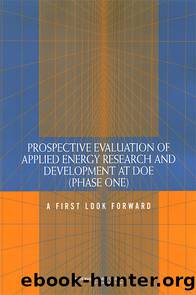PROSPECTIVE EVALUATION OF APPLIED ENERGY RESEARCH AND DEVELOPMENT AT DOE (PHASE ONE): A FIRST LOOK FORWARD by National Research Council of the National Academies

Author:National Research Council of the National Academies
Language: eng
Format: epub
Tags: Energy and Energy Conservation : Policy, Reviews and Evaluations
Publisher: NATIONAL ACADEMY PRESS
Published: 2005-06-29T00:00:00+00:00
B
Statement of Task
The NRC Committee on Benefits of DOEâs Energy Efficiency and Fossil Energy Programs issued its report in the Fall 2001. That committee developed a methodology and benefits matrix for a retrospective evaluation of DOEâs programs in energy efficiency and fossil energy. The committee appointed to conduct the current proposed study will adapt the results of the previous committee with an aim to develop a methodology and matrix for evaluating prospective benefits of DOEâs energy efficiency and fossil energy programs. In addition, the committee will apply its newly developed methodology to evaluate energy efficiency and fossil energy programs. To this end, the committee will
1. Review the methodology(ies) that the Office of Energy Efficiency and Renewable Energy (EE&RE) and the Office of Fossil Energy (FE) are developing to evaluate the prospective benefits of their R&D programs;
2. Consider other methodologies that are being used and/or developed by other groups and analysts for evaluation of R&D benefits, e.g., by OMB, the Energy Information Administration (EIA), etc.;
3. Develop a methodology to evaluate prospective benefits, taking into account the results of the previous NRC report, Energy Research at DOE, Was It Worth It?, as well as what EE&RE, FE, OMB, and others, are developing and incorporating in their efforts. Included will be a delineation of a clear and consistent set of assumptions, guidelines and rules. Every effort will be made to make this methodology as transparent as possible, so that future estimates will be relatively easy for the non-expert observer to understand.
4. Evaluate a number of specific projects in both Fossil Energy and Energy Efficiency using the newly developed methodology. It is too early to predict how many projects will be considered, but it is estimated that the committee will at a minimum choose 5 in Fossil Energy, where projects tend to be large, and 10 in Energy Efficiency, where projects tend to be smaller.
Download
This site does not store any files on its server. We only index and link to content provided by other sites. Please contact the content providers to delete copyright contents if any and email us, we'll remove relevant links or contents immediately.
Whiskies Galore by Ian Buxton(41880)
Introduction to Aircraft Design (Cambridge Aerospace Series) by John P. Fielding(33064)
Rewire Your Anxious Brain by Catherine M. Pittman(18553)
Craft Beer for the Homebrewer by Michael Agnew(18141)
Cat's cradle by Kurt Vonnegut(15186)
Sapiens: A Brief History of Humankind by Yuval Noah Harari(14252)
Leonardo da Vinci by Walter Isaacson(13184)
The Tidewater Tales by John Barth(12608)
Thinking, Fast and Slow by Kahneman Daniel(12079)
Underground: A Human History of the Worlds Beneath Our Feet by Will Hunt(12024)
The Radium Girls by Kate Moore(11921)
The Art of Thinking Clearly by Rolf Dobelli(10224)
A Journey Through Charms and Defence Against the Dark Arts (Harry Potter: A Journey Throughâ¦) by Pottermore Publishing(9232)
Mindhunter: Inside the FBI's Elite Serial Crime Unit by John E. Douglas & Mark Olshaker(9203)
Tools of Titans by Timothy Ferriss(8218)
Wonder by R. J. Palacio(8010)
Turbulence by E. J. Noyes(7936)
Change Your Questions, Change Your Life by Marilee Adams(7635)
Nudge - Improving Decisions about Health, Wealth, and Happiness by Thaler Sunstein(7615)
